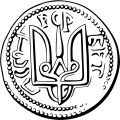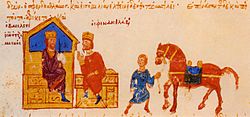Kievan Rus'
Kievan Rus' (also known as Kyivan Rus) was a medieval state in Europe.
Kievan Rus' Русь | |
|---|---|
| 882–13th century | |
 Kievan Rus, 11th century | |
| Capital | Kyiv |
| Common languages | Old East Slavic |
| Religion | Slavic Paganism Orthodox Christianity |
| Government | Monarchy |
| Grand Prince of Kyiv | |
• 882–912 | Oleg |
| Legislature | Veche, Prince Council |
| History | |
• | 882 |
• | 13th century |
| Currency | grivna |
| ISO 3166 code | RU |
Overview
The Kievan Rus lasted from the late 9th to the mid 13th century. It broke apart under the Mongol invasion of 1237–1240. At its peak, it stretched from the Baltic Sea in the north to the Black Sea in the south, and from the upper Vistula in the west to the middle Volga in the east.
Name
The state was called "land of Rus'" in broader sense. In the core sense, this term described the territory of Dnieper Ukraine, which served as the heartland of the state.[1][2][3] The name "Kievan Rus' " was used in the 19th century to mean the time when the center was in Kyiv.[4]
History
The early part of the state is sometimes known as the "Rus Khaganate". The history of Rus' proper begins in 882. This is when prince Oleg seized Kyiv and became the first prince of Kyiv. This was after Varangians (Vikings), who were presumably led by Askold and Dir, became Kyiv's first Norse rulers and freed this slavic city from the Khazars' tribute.[5]
Peak
The state reached its peak of power in the mid 11th century. Its lands went south to the Black Sea, east to the Volga, and west to the Kingdom of Poland and to the Duchy of Lithuania.[6]Volodymyr the Great (980–1015) and his son Yaroslav I the Wise (1019–1054) ruled in the "Golden Age" of Kyiv.
Breakup
With the end of the Viking age, the state lost power in the late 11th and during the 12th century. The broke apart into various rival regional powers.[7]
Legacy
The modern East Slavic states of Ukraine, Belarus and Russia all claim to have got their identity from the early medieval state.[8]
Kievan Rus' Media
Rusĭskaja zemlja from the Primary Chronicle, a copy of the Laurentian Codex
Rus' land in the narrow sense.* 1. After Petro Tolochko* 2. After A. M. Nasonov* 3. After Boris Rybakov
The Invitation of the Varangians by Viktor Vasnetsov: Rurik and his brothers Sineus and Truvor arrive at the lands of the Ilmen Slavs.
The Volga trade route (red), the "route from the Varangians to the Greeks" (purple) and other trade routes of the 8th–11th centuries (orange)
Rus' under the walls of Constantinople (860), the Radziwiłł Chronicle Princess Olga's avenge to the Drevlians, Radziwiłł Chronicle
Madrid Skylitzes, meeting between John Tzimiskes and Sviatoslav
Related pages
References
- ↑ Motsia, Oleksandr (2009). «Руська» термінологія в Київському та Галицько-Волинському літописних зводах ["Ruthenian" question in Kyiv and Halych-Volyn annalistic codes] (PDF). Arkheolohiia (1). doi:10.6084/M9.FIGSHARE.1492467.V1. ISSN 0235-3490. Archived (PDF) from the original on 2 February 2014. Retrieved 25 January 2023.
- ↑ (in Russian) Назаренко А. В. Глава I Archived 2016-03-04 at the Wayback Machine // Древняя Русь на международных путях: Междисциплинарные очерки культурных, торговых, политических связей IX—XII вв. Archived 2012-01-31 at the Wayback Machine — М.: Языки русской культуры, 2001. — c. 42—45, 49—50. — ISBN 5-7859-0085-8.
- ↑ "Российский и русский". Грамота.ру (in Russian). Archived from the original on 2 November 2012. Retrieved 16 January 2012.
{{cite web}}: CS1 maint: unrecognized language (link) - ↑ Tolochko, A. P. (1999). "Khimera "Kievskoy Rusi"". Rodina (in Russian) (8): 29–33.
{{cite journal}}: CS1 maint: unrecognized language (link) - ↑ "Oleg - ruler of Novgorod". Encyclopedia Britannica.
- ↑ "The Russian Primary Chronicle".; see also [1] Archived 2014-05-30 at the Wayback Machine and [2] Archived 2009-05-27 at the Wayback Machine
- ↑ "Kievan Rus' and Mongol Periods". Archived from the original on 2007-09-27. Retrieved 2012-06-04.
- ↑ Plokhy, Serhii (2006). The Origins of the Slavic Nations: Premodern Identities in Russia, Ukraine, and Belarus (PDF). New York: Cambridge University Press. pp. 10–15. ISBN 978-0-521-86403-9. Retrieved 2010-04-27.






